Daily Current Affairs (CA) for UPSC 30th Sep 2025


| Index |
| S.No | Topic | |
| Daily Hindu Analysis (YouTube) |
| 1. | Industrial output growth slows to 4% in August |
|
| 2. | ‘SSTC’ is more than a diplomatic phrase |
|
| 3. | More women employed in agriculture, but half of them are unpaid |
|
| 4. | Two railway links to offer easy connectivity to Bhutan |
|
| 5. | U.S. tariffs will have long-term effect on trade: Commerce Ministry to PAC |
|
| 6. | E-waste collection faces gaps as informal sector plays huge role |
|
| 7. | Suriname pledges to protect 90% of forest | |
| Daily Current Affairs |
| 8. | Swachh Shehar Jodi (SSJ) Initiative |
|
| 9. | Deendayal Lado Lakshmi Yojana |
|
| 10. | Lachipora Wildlife Sanctuary |
|
| 11. | National Initiative on Water Security |
|
| 12. | Musi River |
|
Industrial output growth slows to 4% in August
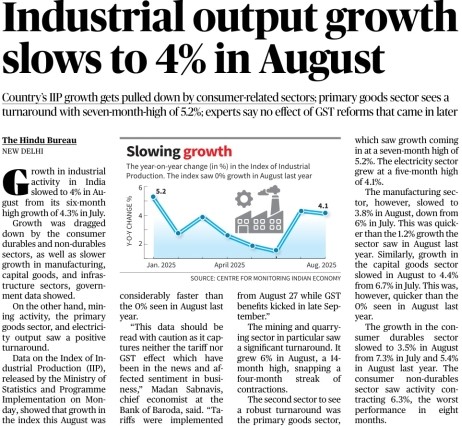
Syllabus Mapping:
- GS Paper 3 (Economy): Indian Economy and issues relating to planning, mobilization of resources, growth, development and employment; Inclusive growth and issues arising from it; Government Budgeting; Effects of liberalization on the economy, changes in industrial policy over the years and their effects on industrial growth.
Why in News? - India’s Index of Industrial Production (IIP) growth slowed to 4% in August 2025, compared to 4.3% in July and a sharp fall from previous months.
- Growth was dragged down by consumer durables, non-durables, manufacturing, capital goods, and infrastructure sectors.
- However, mining, primary goods, and electricity showed a positive turnaround.
What is it All About? ·
The IIP is a key composite index measuring the volume of industrial output across three core sectors: mining (weight: 14.37%), manufacturing (77.63%), and electricity (7.99%). · It uses a basket of 407 item groups (361 from manufacturing) and is classified into sectoral (use-based) categories like primary goods, capital goods, and consumer durables/non-durables. · The August 2025 Quick Estimates (QE) pegged the All-India IIP at 151.7, up from 145.8 in August 2024, but the YoY growth of 4.0% reflects subdued industrial activity.
Key Highlights from August 2025 Data:
- Overall Growth: 4.0% YoY, slower than July's 3.5% (revised) but faster than August 2024's 0%.
- Sectoral Breakdown:
- Mining & Quarrying: Strong rebound at 6.0% (14-month high), snapping a four-month contraction streak, driven by higher coal and metal extraction amid global energy demands.
- Manufacturing: Decelerated to 3.8% from 6.0% in July; quicker than 1.2% last year but dragged by non-durables (e.g., textiles, chemicals).
- Electricity: Grew at 4.1% (five-month high), fueled by rising power demand from urbanization and EVs.
- Use-Based Categories:
- Primary Goods: Seven-month high of 5.2%, signaling upstream recovery.
- Capital Goods: Slowed to 4.4% from 6.7% in July (quicker than 0% last year), indicating moderated investment appetite.
- Infrastructure/Construction Goods: Slower growth, reflecting CapEx moderation.
- Consumer Durables: Eased to 3.5% from 7.3% in July (vs. 5.4% last year), hit by high interest rates and deferred purchases.
- Consumer Non-Durables: Contracted by 6.3% (worst in eight months), pulled down by FMCG and food processing amid rural demand slump.
- Cumulative FY26 (April-August): 4.2% growth, marginally up from 4.1% last year, but below the 5-6% needed for robust GDP expansion.
Link to National Manufacturing Policy (NMP) 2011
The NMP 2011, notified on October 11, 2011, by the Department of Industrial Policy and Promotion (DIPP), aimed to propel manufacturing to 25% of GDP by 2022 (from 16% in 2011) and create 100 million jobs. Key pillars included:
- National Investment and Manufacturing Zones (NIMZs): Greenfield zones with single-window clearance, aiming for 700 sq km across states.
- Ease of Doing Business: Simplified labor/environmental norms, skill development via National Skill Development Mission (NSDM).
- Incentives: Tax holidays, SEZ-like benefits, and FDI liberalization (up to 100% in most sectors).
Achievements and Shortfalls (as of 2025): ·
Only 18 NIMZs were approved (e.g., DMIC in Gujarat), with just 3 operational, generating ~5 million jobs against the 100 million target. · Manufacturing's GDP share stagnated at 15.9% (FY22) and ~16.5% (FY25 provisional), missing the 25% goal by a wide margin due to global slowdowns (2008 crisis), policy flip-flops (e.g., retrospective taxes), and COVID disruptions. · The 2022 extension to 2025 under Make in India reiterated the target, but FY25 data shows ~16.2%, per MoSPI. · Critically, NMP's focus on "clusters" succeeded in auto/electronics (e.g., Tamil Nadu hubs), but labor reforms (e.g., 2020 Codes) face implementation hurdles in states. This IIP slowdown echoes NMP's unfulfilled promise: manufacturing growth averaged 4-5% post-2011, below the 12-14% needed, highlighting the need for demand-side interventions over supply-side incentives.
Relevant Government Schemes
- Make in India (2014): Boost manufacturing, attract FDI, strengthen MSMEs.
- National Policy on Electronics (NPE 2019): Target $400 billion electronics manufacturing by 2025.
- Production Linked Incentive (PLI) Schemes: For sectors like electronics, pharma, textiles, EVs → aim to enhance competitiveness and exports.
- Samarth Udyog Bharat 4.0: Promotes smart manufacturing and Industry 4.0 adoption.
- Atmanirbhar Bharat Abhiyan: Reducing import dependence, promoting domestic production.
- Startup India / Stand-up India: Promoting innovation in manufacturing ecosystems.
- National Infrastructure Pipeline (NIP): ₹111 lakh crore plan (2020–25) to support industrial and logistics growth.
These schemes form a "policy stack" – PLI for scale, Make in India for branding, Atmanirbhar for resilience – but challenges include inverted duty structures and state-center coordination.
Way Forward · Holistically, India's industrial trajectory post-1991 liberalization has shifted from protectionism to integration, but IIP volatility (e.g., 11.4% peak in 2021 to 4% now) underscores the need for a "Third Industrial Revolution" via AI/green tech. · Lessons from NMP: Prioritize R&D (1% GDP spend) and MSME credit (target 20% of bank lending). Globally, emulate Vietnam's 8% manufacturing growth via FTAs (India's 15 CEPA in pipeline). · Domestically, integrate IIP with PMI (August 2025: 57.5) for predictive analytics. · The August data, while concerning, offers a pivot: Leverage PLI's $21B inflows for consumer recovery and GST 2.0 for compliance.
‘SSTC’ is more than a diplomatic phrase 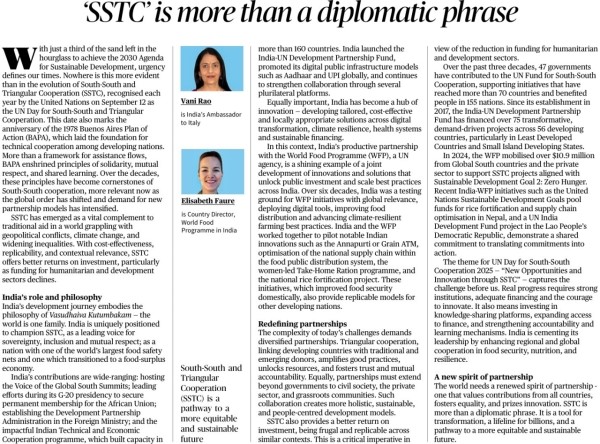
Syllabus Mapping:
- GS Paper 2 (International Relations): Important International institutions, agencies and fora—their structure, mandate; Effect of policies and politics of developed and developing countries on India's interests – Indian diaspora; Bilateral, regional and global groupings and agreements involving India and/or affecting India's interests.
- GS Paper 3 (Economy and Development): Inclusive growth and issues arising from it; Government Budgeting; Technology missions
Why in News? - September 12 is observed as the UN Day for South–South and Triangular Cooperation (SSTC).
- It also marks the anniversary of the 1978 Buenos Aires Plan of Action (BAPA), which laid the foundation for technical cooperation among developing nations.
- The editorial highlights India’s role in SSTC as a leader in providing replicable, cost-effective, and innovative models for global development, particularly in food security, climate resilience, and digital public goods.
What is it All About? · South-South Cooperation (SSC) refers to collaborative efforts among developing countries to share knowledge, technology, and resources for mutual development, bypassing traditional North-South aid dynamics. · Triangular Cooperation (TC) extends this by involving developed nations or multilateral institutions as enablers (e.g., funding or expertise). · Together, SSTC embodies principles of solidarity, mutual respect, and horizontal partnerships, as enshrined in the Buenos Aires Plan of Action (BAPA, 1978), which laid the foundation for technical cooperation among developing nations. · Recognized annually since 2011 by UN General Assembly Resolution 65/212, UN Day for SSTC (September 12) commemorates BAPA's adoption. · The 2025 theme emphasizes innovation—e.g., digital public infrastructure (DPI) like India's Aadhaar and UPI—amid a global order demanding cost-effective alternatives to declining Official Development Assistance (ODA). · SSTC has mobilized $50 billion annually in South-South trade and $20 billion in investments (UNOSSC data, 2024), focusing on SDGs like poverty eradication (Goal 1), zero hunger (Goal 2), and climate action (Goal 13). · India's engagement, rooted in Vasudhaiva Kutumbakam (world as one family), positions it as a "Vishwa Guru" through over 200 development projects in 60+ countries via the India-UN Fund (launched 2018, $150 million corpus). · Examples include WFP partnerships for climate-resilient farming (e.g., Annapurni Grain ATM) and women-led Take-Home Ration programs, benefiting 10 million+ in Africa and Asia.
Core Content Analysis ·
The article positions SSTC as a vital development tool, rooted in the principles of the Buenos Aires Plan of Action, which has evolved since 1978 into a platform for shared learning. · India's leadership is highlighted through its G-20 efforts, securing funding during the Global South Summit and enhancing foreign ministry programs. · The India-UN Development Partnership Fund, with over 75 transformative partnerships (e.g., Nepal rice fund, Lao People's Democratic Republic chain), demonstrates practical impact. · The WFP's Annapurni or Grain ATM develops innovations for food distribution, benefiting 80 million, while Take-Home Ration programs, led by women, provide replicable models. However, the decline in funding—only 47 governments contribute compared to 70 in 2015—poses a challenge. · This argues for strong institutions, adequate financing, and courage to innovate, with India’s DPI exports (e.g., UPI in Bhutan, Singapore) as a global public good enhancing regional and global resilience in food security and nutrition. ·
Theme: 2025 Theme – New Opportunities and Innovation through SSTC encapsulates the article's call for progress through diversified partnerships. Innovations like Aadhaar, UPI, and the Annapurni Grain ATM exemplify how SSTC unlocks resources and amplifies good practices. · India’s leadership in knowledge-sharing and access to finance, bolstered by the India-UN Fund, aligns with this theme, emphasizing accountability and institutional strength to address global inequities effectively.
UPSC Mains "South-South and Triangular Cooperation (SSTC) has evolved as a cornerstone of India's development diplomacy, offering innovative pathways to achieve the SDGs. Critically evaluate its potential and limitations in addressing global inequalities, with reference to India's contributions." (250 words)
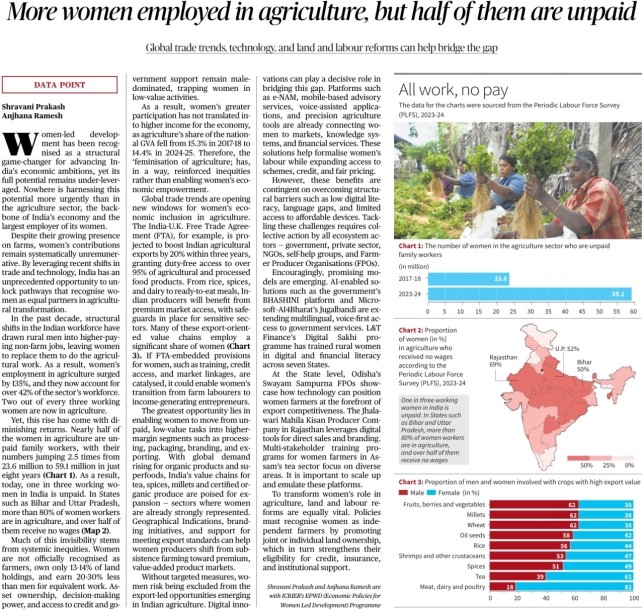
Syllabus Mapping:
- GS Paper 3 (Economy): Indian Economy and issues relating to planning, mobilization of resources, growth, development and employment; Inclusive growth; Major crops-cropping patterns
- GS Paper 1 (Society): Role of women and women's organization; Social empowerment; Salient features of Indian Society.
Why in News? - Recent Periodic Labour Force Survey (PLFS) 2023–24 data shows that while more women are engaged in agriculture, nearly 50% of them are unpaid family workers.
- Despite being the backbone of India’s agricultural economy, women’s contributions remain largely systematically undervalued and unremunerated.
What is it All About? - Women in agriculture:
- Share of women in agricultural employment grew from 15.3% in 2017–18 to 14.4% of Gross Value Added in 2020–25 (despite higher participation, income share remains low).
- Women’s participation has risen as men shift from low-paying farm jobs to higher-paying non-farm jobs, leaving women behind.
- Issue: Women are concentrated in low-value, unpaid tasks with limited access to resources, technology, land rights, and formal markets.
Core Content Analysis 1. Feminisation of Agriculture
- Women now form 42% of the agricultural workforce.
- Over two crore women entered agriculture in the last five years.
- However, half remain unpaid workers → trapped in subsistence roles.
2. Structural Challenges - Land ownership: Only ~13% of operational holdings in India are with women.
- Access to credit: Women face barriers in collateral and formal lending.
- Technology gap: Mechanisation remains male-dominated.
- Market exclusion: Limited involvement in value chains, branding, exports.
- Social barriers: Low digital literacy, mobility restrictions, and wage discrimination.
3. Opportunities from Global Trends - India–UK FTA: Promises duty-free access to 99% of Indian agricultural exports → women involved in high-export crops (fruits, oilseeds, spices) can benefit.
- Digital innovations:
- e-NAM, mobile-based advisory services, AI-enabled tools.
- BHASHINI platform – multilingual AI tools for access to government services.
- Digital Sakhi (L&T Finance): Financial literacy for rural women.
- Odisha’s Swayam Sampurna FPOs: Technology-led competitiveness.
- Export opportunities: Women form majority in cultivation of fruits, vegetables, oilseeds, spices, shrimp – all sectors with high global demand.
4. Government Initiatives - Mahila Kisan Sashaktikaran Pariyojana (MKSP): Empowering women farmers with skill training.
- Self-Help Groups (SHGs): Integrated into National Rural Livelihood Mission (NRLM).
- PM Kisan Samman Nidhi (PM-KISAN): Income support, though not gender-specific.
- e-NAM: Digital agricultural marketing.
- FPO Schemes: Encouraging collective bargaining power, 10,000 FPOs plan with special focus on women.
- Digital India Initiatives: BHASHINI, Aadhaar-enabled services.
5. Way Forward - Ensure land rights and inheritance reforms to empower women farmers.
- Expand access to formal credit and crop insurance.
- Provide gender-sensitive technology and training.
- Strengthen FPOs with women leadership.
- Mainstream women into export-oriented value chains.
- Promote universal recognition of women as “farmers” in policy.
UPSC Mains Women are increasingly forming the backbone of India’s agriculture, but remain unpaid and excluded from value chains.” Critically analyze the challenges faced by women in agriculture and suggest measures to ensure gender-inclusive agricultural transformation. (15 Marks, 250 words)
Two railway links to offer easy connectivity to Bhutan
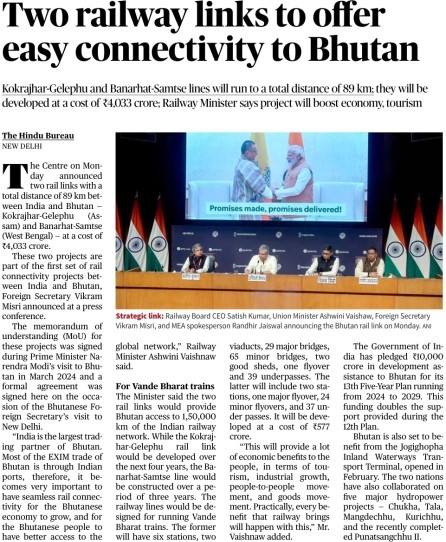
Syllabus: GS Paper 2 : Bilateral, regional and global groupings and agreements involving India and/or affecting India's interests; India and its neighborhood-relations
Why in News?
- The Government of India announced two new railway links between India and Bhutan:
- Kokrajhar–Gelephu (Assam to Bhutan)
- Banarhat–Samtse (West Bengal to Bhutan)
- These projects, with a total length of 89 km and cost of ₹4,033 crore, mark the first-ever rail connectivity between India and Bhutan.
What is it All About? - MoU signed: During PM Narendra Modi’s visit to Bhutan (March 2024).
- Execution: Agreement signed during Bhutanese Foreign Secretary’s visit to India (Sept 2024).
- Objective: Strengthen trade, economy, tourism, and people-to-people connectivity.
- Significance: Bhutan is India’s largest trading partner in South Asia; most of Bhutan’s EXIM trade passes through India.
Core Content Analysis 1. Strategic & Economic Angle - Access to Indian Railway Network:
- Two lines will connect Bhutan to 1,50,000 km of Indian Railways.
- Facilitates EXIM trade and industrial growth.
- Boost to Tourism & Economy: Seamless connectivity to Gelephu and Samtse will encourage cross-border tourism, industrial investments, and local trade.
- Infrastructure Development:
- Banarhat–Samtse line: Includes 2 stations, 1 major flyover, 24 minor flyovers, 27 bridges, 39 underpasses.
- Project cost: ₹577 crore.
2. Diplomatic & Regional Significance - Strengthens India–Bhutan ties, a model of close neighbourhood relations.
- Complements India’s Neighbourhood First Policy and Act East Policy.
- Counters influence of China in the Himalayan region.
3. Development Partnership - India pledged ₹10,000 crore assistance to Bhutan for its 13th Five-Year Plan (2024–2029).
- Ongoing cooperation in hydropower projects (Chhukha, Tala, Mangdechhu, Kurichhu, Punatsangchhu).
- Recent opening of Gelephu Inland Waterways Terminal enhances multimodal connectivity.
4. UPSC Value Addition - Rail Diplomacy: Like India–Nepal and India–Bangladesh rail links, this project expands sub-regional connectivity in South Asia.
- Hydropower Cooperation: Bhutan supplies surplus hydropower to India; a key element in energy security and green energy transition.
- Neighbourhood First Policy: Reinforces India’s commitment to small neighbours’ developmental aspirations (2024 agreement on northern boundaries), safeguarding India's Chicken's Neck (Siliguri Corridor).
- India-Bhutan Bilateral Ties: Rooted in 1949 Treaty (revised 2007), emphasizing mutual security; rail links extend hydropower cooperation (10,000 MW potential by 2030).
- Multilateral Engagements: Aligns with BBIN (Bangladesh-Bhutan-India-Nepal) Motor Vehicles Agreement 2015 for sub-regional connectivity.
- Economic Development: Boosts Northeast's GDP (Assam: 3.5% growth FY25) via trade hubs; links to Act East Policy for ASEAN integration.
- Tourism and Trade: Vande Bharat enables "Bhutan Circuit" tourism; goods movement (e.g., minerals from Bhutan) reduces logistics costs by 25%.
- Environmental and Disaster Management: Projects incorporate climate-resilient designs (e.g., viaducts), linking to NDMA guidelines for Himalayan infra.
- People-to-People Links: Strengthens cultural ties (e.g., shared Buddhist heritage), fostering social harmony in diverse Northeast.
- Government Initiatives and Schemes
| Scheme/Initiative | Launch/Outlay | Key Features & Link to Project | Achievements (as of 2025) |
| Bharatmala Pariyojana (2017) | ₹5.35 lakh crore | Focuses on border roads/rail; includes Northeast connectivity. Funds bridges/underpasses. | 34,800 km completed; 10 border links operational. |
| Sagarmala Programme (2015) | ₹14 lakh crore | Multi-modal logistics; integrates with Jogighopa terminal for Bhutan exports. | 802 projects; reduced logistics cost to 9% GDP. |
| Neighbourhood First Policy (2014) | Integrated in MEA budget (₹22,000 crore FY25) | Prioritizes Bhutan; grant aid for infra. | 50+ projects; $2B lines of credit. |
| Act East Policy (2014) | ₹10,000 crore for Northeast | Enhances ASEAN links via Bhutan; supports Vande Bharat. | 20% trade growth with East Asia. |
| India-Bhutan Development Cooperation (Ongoing) | ₹10,000 crore for Bhutan's 13th Plan | Covers rail/hydropower; doubles previous aid. | Punatsangchhu II (1,020 MW) commissioned. |
| PM Gati Shakti (2021) | ₹100 lakh crore | Digital planning for seamless infra; maps rail links. | 1,500+ layers; 30% faster approvals. |
UPSC Prelims Q.
With reference to India–Bhutan relations, consider the following statements:
1. The Kokrajhar–Gelephu and Banarhat–Samtse rail projects are the first-ever rail connectivity links between India and Bhutan.
2. Bhutan is India’s largest trading partner in South Asia.
3. India has pledged development assistance to Bhutan in its 13th Five-Year Plan (2024–2029).
4. The Gelephu Inland Waterways Terminal was developed by India as part of multimodal connectivity. Which of the above statements is/are correct?
A) 1, 2 and 3 only
B) 1, 3 and 4 only
C) 2 and 4 only
D) 1, 2, 3 and 4
Answer: D) 1, 2, 3 and 4
U.S. tariffs will have long-term effect on trade: Commerce Ministry 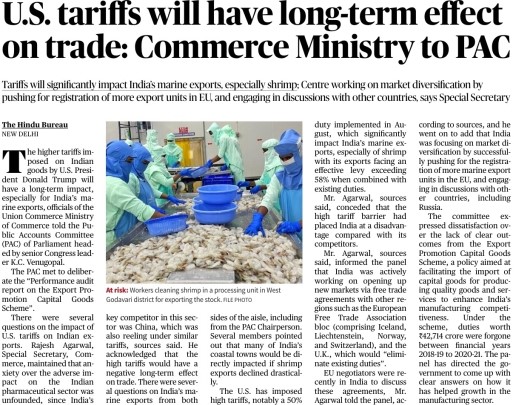
Syllabus Mapping - GS Paper 3: Indian Economy – external sector, exports, schemes for competitiveness (EPCG, SEZ, PLI).
- GS Paper 2: Bilateral relations (India–U.S.), role of WTO, impact of protectionism.
Why in News? - The U.S. has imposed higher tariffs on Indian goods under the Trump administration.
- This is expected to have a long-term impact on India’s marine exports, especially shrimp, with effective duties exceeding 58% when combined with existing tariffs.
- The Commerce Ministry informed the Public Accounts Committee (PAC) that India is actively seeking market diversification (EU, Russia, other regions).
What is it All About? - Key issue: Shrimp exports hit hardest → India is the largest exporter of shrimp globally (especially to U.S.).
- Competitor: China also facing similar tariffs, but India still disadvantaged due to higher costs.
- PAC review: Also discussed poor performance of Export Promotion Capital Goods (EPCG) Scheme.
Core Content Analysis 1. Impact of U.S. Tariffs on India - Marine exports: Shrimp exports face >58% effective levy → reduces competitiveness.
- Pharma sector: Earlier fears of U.S. tariffs unfounded; impact limited.
- Long-term effect: Tariffs erode India’s market share and affect rural livelihoods (as aquaculture is employment-intensive).
2. India’s Response - Market Diversification:
- Registration of more export units in EU.
- Negotiations with Russia and European Free Trade Association (EFTA) (Switzerland, Norway, Iceland, Liechtenstein).
- EU FTAs to “eliminate existing duties.”
- Engagement in WTO: Highlighting adverse impacts of tariff barriers.
- Exploring New Markets: Africa, Latin America for seafood exports.
3. Export Promotion Capital Goods (EPCG) Scheme - Objective: Allow duty-free import of capital goods to enhance export competitiveness.
- Issue flagged by PAC: Lack of clear outcomes → ₹42,714 crore of duties forgone (2018–19 to 2020–21) without proportional export gains.
- PAC direction: Government must rationalise incentives and review EPCG effectiveness.
4. Broader Trade Policy Implications - Tariffs highlight vulnerability of India’s export basket (shrimp, textiles, steel, pharma).
- Need for FTAs: Ongoing India–EU FTA, India–EFTA FTA, India–UK FTA critical.
- Links to Atmanirbhar Bharat – need to strengthen domestic competitiveness.
- WTO disputes remain key – India has filed complaints against U.S. tariffs earlier.
Other Relevant Info for UPSC - Marine Products Export Development Authority (MPEDA): Statutory body under Commerce Ministry regulating seafood exports.
- India’s shrimp exports: ~70% of farmed shrimp exported; U.S. is top market.
- Trade statistics: Merchandise exports (2023–24) ~$437 billion, services ~$340 billion.
UPSC Prelims Q. With reference to India’s seafood exports, consider the following statements: 1. India is the world’s largest exporter of farmed shrimp. 2. The U.S. is the single largest destination for India’s shrimp exports. 3. The Marine Products Export Development Authority (MPEDA) functions under the Ministry of Agriculture & Farmers’ Welfare. Which of the above statements is/are correct?
A) 1 and 2 only
B) 2 and 3 only
C) 1 only
D) 1, 2 and 3
Answer: A) 1 and 2 only
E-waste collection faces gaps as informal sector plays huge role
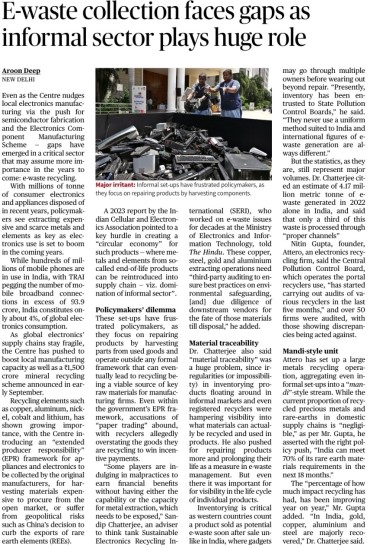
Syllabus Mapping
- GS Paper 3:
- Environment: Waste management, pollution, resource efficiency.
- Economy: Critical minerals, manufacturing competitiveness.
- Science & Tech: Electronics, semiconductors, circular economy.
GS Paper 2: Governance issues, regulation, informal sector role
Why in News?
- With India’s electronics manufacturing push (semiconductor fabrication, Electronics Component Manufacturing Scheme, and ₹1,500 crore e-waste recycling scheme), e-waste recycling has emerged as a critical sector.
- However, policymakers face hurdles as the informal sector dominates collection and recycling, raising issues of traceability, compliance, and environmental safety.
- In 2022, India generated 4.17 million metric tonnes of e-waste, but only about one-third was processed through formal channels.
What is it All About? - E-waste definition: Discarded electronic appliances (phones, laptops, TVs, etc.) and components containing metals like copper, nickel, cobalt, lithium.
- India’s electronics consumption: 93.9 crore mobile connections (TRAI) → India = 4% of global consumption.
- Challenge: Informal recycling dominates → repairs and resale thrive, but lack formal accountability or traceability.
Core Content Analysis 1. Scale of the Problem - 4.17 million tonnes of e-waste generated in 2022 (India among top producers).
- Only 1/3rd processed through official Extended Producer Responsibility (EPR) channels.
- Informal markets dominate → lead to unsafe extraction, pollution, and material losses.
2. Informal Sector’s Role - Informal recyclers repair, reuse, or extract metals from discarded electronics.
- Creates livelihood but lacks environmental safeguards.
- Results in “paper trading” where recyclers overstate collections to claim EPR credits.
3. Policy & Regulatory Gaps - EPR (Extended Producer Responsibility): Mandates producers to collect/recycle e-waste → plagued by loopholes.
- Traceability challenge: Lack of system to track metals through lifecycle.
- Auditing: Recent inspections showed discrepancies in >50 registered recyclers.
4. Material Security & Strategic Importance - Critical minerals (lithium, cobalt, nickel, rare earths) essential for semiconductors, batteries, and EVs.
- Global supply chains fragile (China’s dominance in critical minerals).
- India could meet 70% of its rare earth needs through efficient e-waste recycling.
5. Industry & Innovation Responses - Companies like Attero setting up large recycling units in “mandi-style” aggregation.
- Calls for AI-enabled inventory systems for better visibility of waste flows.
- Push for integration of informal sector with training and technology.
Other Relevant Info for UPSC - International context: Global e-waste ~50 million tonnes/year (UN estimate).
- India’s policy: E-Waste (Management) Rules, 2016 → updated in 2022 with stricter EPR norms.
- Circular economy link: Recycling critical for Atmanirbhar Bharat, sustainable development, and climate targets.
- SDGs: SDG 12 (Responsible Consumption and Production), SDG 13 (Climate Action).
Policy Framework and Reforms - E-Waste (Management) Rules, 2022: Mandates EPR with phased targets (60% FY25, 80% FY28); integrates RoHS for hazardous substances.
- Recent Initiatives: ₹1,500 crore scheme (September 2025) for mineral recycling; PLI for electronics (₹76,000 crore) ties to EPR, aiming 20% local value addition.
- Global Alignment: Basel Convention (1989, India acceded 1992) regulates transboundary waste; Stockholm Convention on POPs addresses e-waste toxins.
Environmental and Health Impacts - Pollution Linkages: Informal recycling emits 1.2 million tonnes CO2-equivalent annually (TERI 2024), contaminating soil in hotspots like Seelampur (Delhi).
- Health Burden: Affects 4 million informal workers (ILO 2023); links to SDG 3 (Health) and 12 (Responsible Consumption).
Economic and Resource Security - Critical Minerals Angle: E-waste holds 50x more gold than ore (UN 2024); supports National Critical Minerals Mission 2023 for 30 minerals.
- Informal Sector Economics: Generates ₹15,000-20,000 crore (CII 2025) but evades taxes; formalization could add 1% to GDP via recycling hubs.
- Global Comparison: Japan's 98% collection rate via producer fees; China's informal crackdown (2024) offers lessons for India's 2025 audits.
Technological and Innovation Aspects - Innovations in Recycling: Attero's hydrometallurgical units recover 99% REEs; AI traceability (e.g., blockchain pilots by CPCB) addresses "material traceability" gaps.
- Challenges in Formalization: High costs (₹50,000/tonne vs. informal ₹10,000) deter uptake; needs subsidies under Swachh Bharat 2.0.
UPSC Prelims Q. With reference to
e-waste management in India, consider the following statements:
1. The E-Waste (Management) Rules mandate Extended Producer Responsibility (EPR), making producers responsible for collection and recycling.
2. India generated more than 4 million tonnes of e-waste in 2022, of which over 70% was processed through formal channels.
3. E-waste contains critical minerals such as lithium, cobalt, and nickel, which are vital for semiconductors and electric vehicle batteries. Which of the above statements is/are correct? A) 1 and 2 only
B) 2 and 3 only
C) 1 and 3 only
D) 1, 2 and 3
Answer: C) 1 and 3 only
Suriname pledges to protect 90% of forests
Syllabus mapping:
- GS Paper 3:
- Environment → Conservation, afforestation, carbon sinks.
- Biodiversity & Climate Change.
- Energy transition & sustainable development.
- GS Paper 2:
- International climate agreements (Paris Agreement, COP summits).
- Role of Global South in climate governance.
Why in News? - During Climate Week in New York, Suriname’s government pledged to permanently protect 90% of its tropical forests.
- This is considered among the most ambitious global commitments to climate and biodiversity by an Amazonian country.
- The pledge comes ahead of COP30, to be held in Belém, Brazil, in the Amazon region.
What is it All About? - Forest coverage: Suriname is already ~93% forested.
- Suriname is one of the only three countries in the world that absorb more CO₂ than they emit (carbon-negative or net-positive countries).
- The pledge surpasses the “30x30” UN-backed target → to protect 30% of land and oceans by 2030.
- Aim: Protect 15 million hectares of tropical rainforest permanently, update conservation laws, and enhance protections for indigenous and Maroon peoples’ ancestral lands.
Core Content Analysis 1. Global Climate Context - Forest protection crucial for carbon sequestration.
- Amazon rainforest = “lungs of the Earth”, but threatened by deforestation.
- Suriname’s pledge sets a new benchmark for climate action.
2. Net-Positive Countries - Only three countries globally absorb more CO₂ than they emit:
- Known as carbon-negative countries or net-positive contributors.
- India aims for net-zero by 2070 via forests (sequestering 3 GtCO2e/year, per MoEFCC 2025), with 8 countries (including Panama, Costa Rica) leading tropical sink efforts.
- Carbon Markets and REDD+: $20 million funding ties to India's Carbon Credit Trading Scheme (2023), enabling offsets for industries; net-positive status inspires India's afforestation (2.5 crore ha target by 2030 via CAMPA).
3. Relevance for Energy Transition (India Angle) - India’s energy transition depends heavily on balancing economic growth with ecological protection.
- India’s Forests & Carbon Sink commitments under NDCs (Net Zero by 2070).
- Expanding forest cover & conservation = vital for carbon markets, biodiversity credits, and Just Energy Transition Partnership (JETP).
- Lessons from Suriname → ecotourism, carbon finance, local community empowerment as revenue alternatives.
4. Indigenous & Local Rights - Indigenous and tribal land rights not legally recognized in Suriname → international concern.
- India too faces challenges in Forest Rights Act (FRA) implementation.
- Recognizing local communities’ role in conservation is critical.
5. International Support - Environmental donors pledged $20 million for Suriname’s efforts.
- Highlights importance of global climate finance and cooperation.
- Sets precedent for Amazonian nations (Brazil, Peru, Colombia, Venezuela, Ecuador, Guyana, Bolivia, Suriname = 8 Amazon countries).
Other Relevant Points - Suriname’s biodiversity: jaguars, tapirs, giant river otters, 700 bird species, blue poison dart frog.
- Illegal mining, logging, and road-building remain challenges.
- Pledge could become a model for sustainable extraction + conservation balance.
- Global Biodiversity Framework: Surpasses "30x30" target; links to CBD COP16 (2024) outcomes on Indigenous rights.
- Global South Solidarity: Aligns with G77+China advocacy at COP for $1 trillion adaptation finance.
UPSC Prelims Q. Which of the following countries are currently recognised as
net carbon-negative nations (absorbing more CO₂ than they emit)? 1. Suriname 2. Bhutan 3. Panama 4. Nepal
Options: A) 1 and 2 only
B) 1, 2 and 3 only
C) 2, 3 and 4 only
D) 1, 2, 3 and 4
Answer: B) 1, 2 and 3 only
Swachh Shehar Jodi (SSJ) Initiative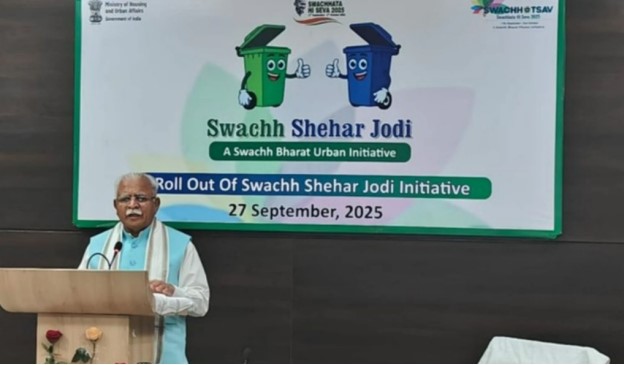
Syllabus: GS Paper II – Governance: Government Policies & Interventions
Context:
The Ministry of Housing and Urban Affairs (MoHUA) launched the Swachh Shehar Jodi (SSJ) programme in 2025, pairing 72 mentor cities with around 200 mentee cities to improve sanitation and waste management through mentorship and collaboration. Key Points
- Objective: A time-bound mentorship programme to promote peer learning in sanitation and waste management.
- Selection Basis: Mentor and mentee cities identified from Swachh Survekshan rankings.
- Structure: Involves 72 mentor cities and ~200 mentee cities; nearly 300 MoUs signed nationwide.
- Implementation: Mentor–mentee pairs prepare joint action plans with milestones; includes a 100-day intensive phase.
- Focus Areas: Strengthening sanitation infrastructure, waste segregation, collection, disposal, and promoting community participation.
- Activities: Includes training, workshops, field visits, and adoption of successful models.
- Monitoring: Progress assessed through predefined milestones and reflected in Swachh Survekshan 2026 rankings.
- Outcome Goal: Achieve sustainable urban cleanliness, innovation in waste management, and create replicable success stories.
Source: PIB
Deendayal Lado Lakshmi Yojana
Syllabus: GS Paper II – Governance: Welfare Schemes for Vulnerable Sections
Context: The Haryana Government launched the Deendayal Lado Lakshmi Yojana in 2025 on the birth anniversary of Pandit Deendayal Upadhyaya, providing ₹2,100 monthly assistance to eligible women to promote empowerment and welfare.
Key Points
- Objective: Strengthen women’s economic and social status, especially from marginalised groups.
- Eligibility: Women aged 23–60 years, with family income below ₹1 lakh annually; both married and unmarried women eligible.
- Household Coverage: Multiple women in a single family can avail the benefit.
- Financial Support: Provides ₹2,100 monthly through Direct Benefit Transfer (DBT).
- Beneficiaries (Phase I): About 20 lakh women to be covered initially.
- Budget Allocation: ₹5,000 crore earmarked for FY 2025–26 to ensure timely payments.
- Significance: Part of the government’s Sankalp Patra commitments for women’s welfare.
Source: PIB
Lachipora Wildlife Sanctuary

Syllabus:
GS Paper III – Environment: Biodiversity & Wildlife Conservation
Context: The District Magistrate of Baramulla has ordered the immediate closure of 14 gypsum mining units operating within the prohibited 1-km radius of Lachipora Wildlife Sanctuary, citing ecological protection concerns. Key Points
- Location: Situated in Baramulla district, J&K, near Lachipora village, on the northern banks of the Jhelum River.
- Establishment: Declared a sanctuary in 1987 to protect the endangered Markhor (wild goat with twisted horns).
- Area: Spread over 141 sq. km with elevations ranging from 1,630–3,300 m.
- Landscape: Features alpine meadows, rocky cliffs, and slopes ranging from gentle to steep.
- Flora: Rich in coniferous forests (deodar, blue pine, white pine) and broadleaf trees (birch, horse chestnut, fir, walnut).
- Fauna: Habitat for Hangul (Kashmir stag), Himalayan black bear, Snow leopard, Musk deer, and other mammals.
- Avifauna: Recognized as an Important Bird Area (IBA), home to the vulnerable Western Tragopan.
Source: Greater Kashmir
National Initiative on Water Security Syllabus: GS Paper III – Environment & GS Paper II – Governance: Water Resources Management Context: The
Government of India launched the
National Initiative on Water Security to integrate
water conservation with rural employment schemes and ensure sustainable water use in rural areas.
Key Points - Launch: Jointly launched by Shivraj Singh Chouhan (Agriculture & Farmers’ Welfare) and C R Patil (Jal Shakti) in New Delhi.
- MGNREGA Funding: 65% of funds for over-exploited/critical rural blocks and 40% for semi-critical blocks to be used for water conservation works.
- Focus Areas: Includes rainwater harvesting, groundwater recharge, watershed management, and sustainable irrigation practices.
- Beneficiaries: Supports farmers, rural communities, livestock, and ensures long-term environmental benefits.
- Environmental Impact: Promotes ecological balance while securing water for agriculture and rural livelihoods.
- Government Priority: Part of PM Narendra Modi’s focus on water conservation and sustainable rural development.
Source: PIB
Musi River
Syllabus: GS Paper I – Geography: Rivers & Water Resources Context: The Musi River is in spate due to heavy rains and water release from Osman Sagar and Himayat Sagar, leading to flooding in Hyderabad and submerging localities and bus stations. Key Points
- Tributary: Major tributary of the Krishna River, also called Muchukunda/Musunuru River.
- Origin: Rises in the Ananthagiri Hills near Vikarabad, Telangana.
- Course: Flows eastward across Telangana, turns south at Chittaloor, and joins Krishna River at Vadapally (Nalgonda district).
- Urban Role: Divides Hyderabad into the Old City and the newer city; influenced its settlement pattern.
- Reservoirs: Forms Osman Sagar and Himayat Sagar, supplying drinking water to Hyderabad & Secunderabad.
- Flood-Prone: Frequently causes urban floods during heavy rains or sudden reservoir releases.
Source: New Indian Express (NIE)










